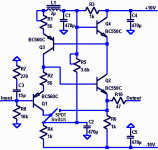No, not me although i would love to go there.
Maybe you see Stig Björge.
I build the other channel and i am listening.
First i had something that sounded like oscillation. That was a contact problem. Eichmann Plugs on WTB jacks is really crap.
First impressions : very nice treble on Marie Boine Remixed. A lot of details, transparent and resolved but not sharp.
Maybe you see Stig Björge.
I build the other channel and i am listening.
First i had something that sounded like oscillation. That was a contact problem. Eichmann Plugs on WTB jacks is really crap.
First impressions : very nice treble on Marie Boine Remixed. A lot of details, transparent and resolved but not sharp.
Besides:
anyone here who will be in HongKong the next week for the audio fair? I'll be there from Tuesday on. Maybe we can meet us in Kowloon.. ?
Hallo Jürgen,
unfortunately this year its not yet possible -
I had just spoken to Stig - he will go to Singapore for some
important Audio work - I missed if he said sth about going to Hongkong as well
Anyway, enjoy the trip and I wish you and your collegues a wonderful time
Joachim , I am very happy two channels are working again...
Kean, I had the chance to listen to the construction on the Tangram speakers
and with the brandnew rauschfrei for two full days before one channel went on "a momentary leave of absence"....
there is somthing very impressive and winning about the sound of your
buffer at Joachims place and at the time Joachim
and I agree its more than worth it to follow up this aproach and inquire further to where your design will lead us to sonically.
We have often at Joachims place very precise setups, so it helps to pinpoint and
identify acoustic ( sorry for my english here - not native language) phenomenas
So far I do agree with the way Joachim tried to describe the music reproduction
quality. It is undoubtably " ausgeformt" in all criterias has a profound tonality and I loved the information, speed, naturalness, big punch, small punch, energy everywhere - and it did like my amplifiers also, so even more pleasure
on my side..
We had more precission in the criteria Joachim called "Focus"
with one of the other buffers then..
Joachims system has a really precise and big soundstage
wide and deep and dynamically homogenous, meaning :
Big dynamics and still open to all acoustic information at any level in that monent ...
when dynamic information should be tiniest they shouldn't be attificially thrown in your face but still precisely audible and distinguished from all other
musical contributors - Joachims system allows to audition including these
criterias in most of the setups these days.
eg : dynamic informations when far away are also very clear and " formed " well belonging to the instrument even at pianissimo.
So with this reproduction environment , we spend hours with listening
and I enjoyed especially the buffer comparison and the rauschfrei ( for a long time Joachim and i didn't have a rauschfrei in our hands, so it really was
an evening that was very enjoyable , no stress but joy in listening!)
Thanks Kean for the sharing and a heartfelt WOW! regarding the result
Good Night ( as if Audio People ever sleep..)
Martina
PS forgot to name the complete system Joachim used when I had the chance to listen to
Keans buffer
Lyra Titan i MC with Centroid Tonarm, Immedia spiral groove turntable
Also we tried with the Kean a little Rega with AKG P8 ES retipped which was fun
cable were Mundorf (silver/gold) , Wireworld, a cable Alan Perkins supplied, Nordost
and Matthias Kurz cables - so when we would doubt any oscillation is induced
by interaction with a given cable design , Joachim inquires quite quickly and we
have enouhj stuff that collected itself at Joachims place to swap
Phonostages - you name it! - any MPP stage
we started with the valve phono, then the Rauschfrei ( three cheers!)
and two MM versions from this MPP thread with the little Rega deck
Buffers where Kean and two others, Joachim could give the name if wanted , because
I simply cannot remember what the design was - one was an upgraded double
mono design, that we gave the best verdict for that moment of testing
Power Amp an LA Audio version ( Modified by Joachim and friends)
As well as another prototype Amp
Speaker were a new development Joachim names Tangram
on other occassins we have some other speakers of Joachims fundus at hand
many with very good chassis to listen to.
I would consider his system to be of great monitor quality, so it helps to identify
what halpens sonically, but also test ones temptation to just " like or dislike" something
without proof - Joachims system allowed me quite often to find, identify
and correct built errors -
Last edited:
( sorry for my english here - not native language)
Det Allet is doch janz jut zu kapieren, gell.
(always a treat, not just in German)
Hi Jacco
great to " hear " your voice in the middle of the night!
I remembered listening with you at the ETF when I wrote the post
- you would have enjoyed hours of great music , and at some stage very good red wine ,
and " Erdnussflips" - Joachim had a weak spot - that was fun , because I never saw him eating " Erdnussflips" ever before...
Remember Stella a Maris quite well!!!!
Martina
great to " hear " your voice in the middle of the night!
I remembered listening with you at the ETF when I wrote the post
- you would have enjoyed hours of great music , and at some stage very good red wine ,
and " Erdnussflips" - Joachim had a weak spot - that was fun , because I never saw him eating " Erdnussflips" ever before...
Remember Stella a Maris quite well!!!!
Martina
Last edited:
Thanks!
It is extremely hard to achieve realism without sibilance. I have always been in struggle between dullness and sibilance. So much so that I have hardly been able to focus on anything else! It seems almost everything sounds like either a lawnmower or a chalkboard, and none of it realistic at all, but I'm glad to say this buffer does a very good job, and gets close to making breath and that dreaded S sound real. I wonder why that is.
PS. My system is very cheap and probably terrible. I use BetsyK's on a huge 4cm thick plank, basically an open baffle. My source is my computer on-board audio, which is actually not bad and has a low noise floor. My amp is just an Lfet output stage I've been messing with.
It is extremely hard to achieve realism without sibilance. I have always been in struggle between dullness and sibilance. So much so that I have hardly been able to focus on anything else! It seems almost everything sounds like either a lawnmower or a chalkboard, and none of it realistic at all, but I'm glad to say this buffer does a very good job, and gets close to making breath and that dreaded S sound real. I wonder why that is.
PS. My system is very cheap and probably terrible. I use BetsyK's on a huge 4cm thick plank, basically an open baffle. My source is my computer on-board audio, which is actually not bad and has a low noise floor. My amp is just an Lfet output stage I've been messing with.
Last edited:
Hi Kean
I just had a long post written to distinguish further the sibilance / dullness part!
....
and the I missed the ipad going down so no nice text left
all in Internet Nirvana
Now I feel dull and my mind is sibilating...
Apart from my mishap, thank you, Kean for pointing that out!
iIt is a very important point you refer to , and because of that I will take the time asop to rewrite my post.
Now I will go to the land of bright colors, wonderful dreams and forget all pads, ipads, earpads, eyepads, etc at once
Martina
I just had a long post written to distinguish further the sibilance / dullness part!
....
and the I missed the ipad going down so no nice text left
all in Internet Nirvana
Now I feel dull and my mind is sibilating...
Apart from my mishap, thank you, Kean for pointing that out!
iIt is a very important point you refer to , and because of that I will take the time asop to rewrite my post.
Now I will go to the land of bright colors, wonderful dreams and forget all pads, ipads, earpads, eyepads, etc at once
Martina
Some recordings have sibilance, no matter what. That is not a fault of the reproduction chain. Two examples are Hellen Merrill in Tokyo and Diana Krall Live in the Olympia.
I use them and when i can borderline stand the sound i know it´s fine on virtually all other recordings.
Some speakers and some cartridges are sibilant, no matter what. That is a transducer problem. I prefer to use very good speakers and cartridges, well set up.
When electronics add sibilance there is something wrong big time.
I use them and when i can borderline stand the sound i know it´s fine on virtually all other recordings.
Some speakers and some cartridges are sibilant, no matter what. That is a transducer problem. I prefer to use very good speakers and cartridges, well set up.
When electronics add sibilance there is something wrong big time.
Today is Keantoken buffer day. That buffer really bugged me. At first i had several HickUps. With the first version one channel went bust. I repaired it by changing the transistors ( i thought ), it worked and went bust again after i had switched the batteries off and on again. Then i build the latest version. It worked. Then i made a small change to the layout and it stopped to work on both channels ! I exchanged some PMs with Kean.
I was prepared to send it over but i got it working again. I think i have it stable now.
I did not change much, only a little different wiring around the 2uH coils. I switched it on and off several times, no problem.
I had only listened to the buffer with digital so far. With my Forsell Air Reference CD
player and with my MacBook Pro, Amarra and Curryman DAC. Amarra sounded considerably better so my Forsell will retire even more. After 20yeras of hard work it deserves it.
Today i set up my vinyl system and i put on my magnetostatic panels with active M-Dipole sub. At the moment i am listening to a phono stage that has no name. It is meant to be mounted inside a Bauer Audio turntable to safe the phono cable. That stage has a very tight and dynamic sound and that came over with the buffer. I have still to listen to some other recordings but i already get good separation and focus. Maybe the sound is not as "high" as i am used too but perspective is natural. When i am through with this phono i will switch on my tube phono that has a warmer and bigger sound but is also quite detailed. What was very interesting with the noname phono that it is two possibilities to connect the PSU, in this case two center tapped lead acid batteries. In can play floating, that is not connecting the center tap, and also "conventional " with a plus-minus supply.
It sounded much better with plus-minus. Sweeter, less hard, better fleshed out.
The buffer brought out that difference easy. The setup is a bit hard to explain so here first come some pictures.
I was prepared to send it over but i got it working again. I think i have it stable now.
I did not change much, only a little different wiring around the 2uH coils. I switched it on and off several times, no problem.
I had only listened to the buffer with digital so far. With my Forsell Air Reference CD
player and with my MacBook Pro, Amarra and Curryman DAC. Amarra sounded considerably better so my Forsell will retire even more. After 20yeras of hard work it deserves it.
Today i set up my vinyl system and i put on my magnetostatic panels with active M-Dipole sub. At the moment i am listening to a phono stage that has no name. It is meant to be mounted inside a Bauer Audio turntable to safe the phono cable. That stage has a very tight and dynamic sound and that came over with the buffer. I have still to listen to some other recordings but i already get good separation and focus. Maybe the sound is not as "high" as i am used too but perspective is natural. When i am through with this phono i will switch on my tube phono that has a warmer and bigger sound but is also quite detailed. What was very interesting with the noname phono that it is two possibilities to connect the PSU, in this case two center tapped lead acid batteries. In can play floating, that is not connecting the center tap, and also "conventional " with a plus-minus supply.
It sounded much better with plus-minus. Sweeter, less hard, better fleshed out.
The buffer brought out that difference easy. The setup is a bit hard to explain so here first come some pictures.
Attachments
-
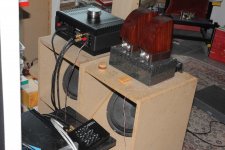 KeanSe sub behind.jpg317.4 KB · Views: 395
KeanSe sub behind.jpg317.4 KB · Views: 395 -
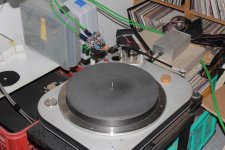 KeanSe turntable zeitreise.jpg314.5 KB · Views: 397
KeanSe turntable zeitreise.jpg314.5 KB · Views: 397 -
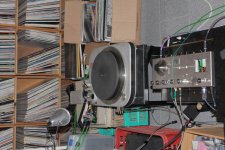 KeanSe Turnatble tube phono.jpg514 KB · Views: 394
KeanSe Turnatble tube phono.jpg514 KB · Views: 394 -
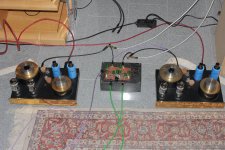 KeanSe buff amp.jpg736.2 KB · Views: 389
KeanSe buff amp.jpg736.2 KB · Views: 389 -
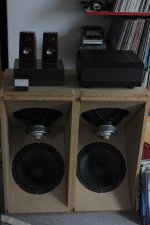 KeanSe sub front.jpg280.6 KB · Views: 371
KeanSe sub front.jpg280.6 KB · Views: 371 -
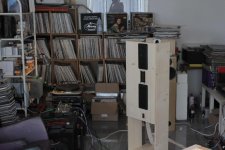 KeanSe speaker left.jpg241.9 KB · Views: 172
KeanSe speaker left.jpg241.9 KB · Views: 172 -
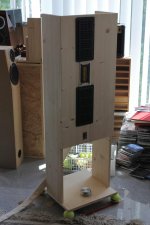 KeanSe speaker right.jpg201.6 KB · Views: 186
KeanSe speaker right.jpg201.6 KB · Views: 186 -
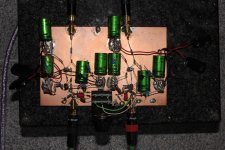 KeanSe buffer.jpg330.2 KB · Views: 213
KeanSe buffer.jpg330.2 KB · Views: 213
I am listening to music. I found the magic combination.
I changed the opamp based phono stage to a discrete JFet stage.
It is known as " The Hulk " because of the many green Leds.
Some call it " Crystal" because Martina put a big crystal on the Leds at ETF in france some years ago. The very slight hardness is gone and resolution and dynamics are even better.
I have no questions, i am satisfied.
This version of the buffer is a more or less open window to the sounds of this world.
I changed the opamp based phono stage to a discrete JFet stage.
It is known as " The Hulk " because of the many green Leds.
Some call it " Crystal" because Martina put a big crystal on the Leds at ETF in france some years ago. The very slight hardness is gone and resolution and dynamics are even better.
I have no questions, i am satisfied.
This version of the buffer is a more or less open window to the sounds of this world.
Kean's Kuartlotron Buffer, H2 option switch
On a documentation spree again, here's Kean's Kuartlotron Buffer with the switchable sonic signature option installed. Kind of like tube swapping except much more convenient. And instead of changing a lot of other equipment around or buying a different source for a sonic signature matchup, you may be able to just flip the switch on the buffer. See attachment.
Since the effect is mild and does not decrease resolution, it may be so mild that some people wouldn't notice, especially inert on systems that might not need a buffer.
Switch position shown in the schematic is "effect cancel" for normal operation.
A DPDT switch could be used to switch a stereo pair of buffers.
On a documentation spree again, here's Kean's Kuartlotron Buffer with the switchable sonic signature option installed. Kind of like tube swapping except much more convenient. And instead of changing a lot of other equipment around or buying a different source for a sonic signature matchup, you may be able to just flip the switch on the buffer. See attachment.
Since the effect is mild and does not decrease resolution, it may be so mild that some people wouldn't notice, especially inert on systems that might not need a buffer.
Switch position shown in the schematic is "effect cancel" for normal operation.
A DPDT switch could be used to switch a stereo pair of buffers.
Attachments
Last edited:
Cool, Kean mentioned that in PM to me. I will try it tomorrow.
I know, you hate YouTube but watch the bassplayeres.
JEFF BECK LIVE Cause We've Ended As Lovers - YouTube
I know, you hate YouTube but watch the bassplayeres.
JEFF BECK LIVE Cause We've Ended As Lovers - YouTube
There is no telling what will happen when you flip that switch. While it is unconnected Q1 will be in deep saturation, input and output will clip to the positive rail. If your source impedance is small, or a headphone amp, it may not be an issue. If you have an input cap, output will clip more slowly. If nothing is connected to the input, it will be a very violent transaction.
I have been thinking about how to make the switch with minimal problems for those interested in the effect. You could use a switch which is momentarily shorted rather than momentarily open, but this will need to be tested in real life and may cause problems as the switch fails.
I have been thinking about how to make the switch with minimal problems for those interested in the effect. You could use a switch which is momentarily shorted rather than momentarily open, but this will need to be tested in real life and may cause problems as the switch fails.
I know, you hate YouTube but watch the bassplayeres.
JEFF BECK LIVE Cause We've Ended As Lovers - YouTube
Masterpiece!
